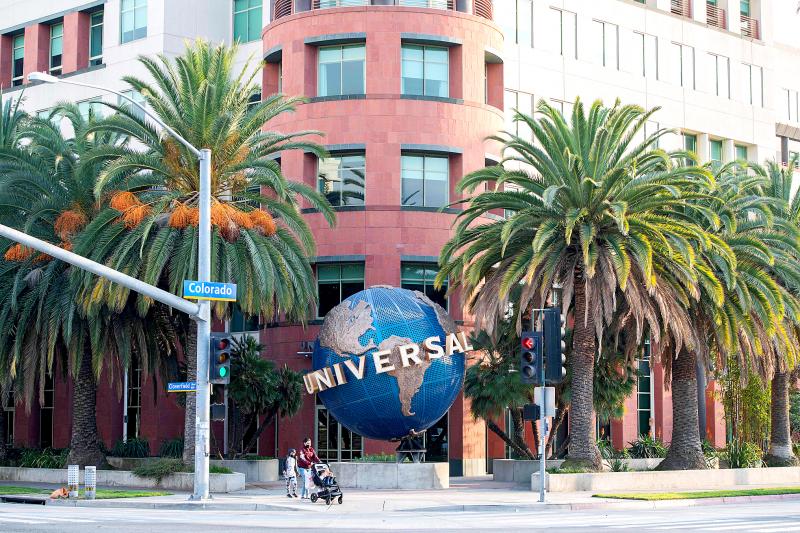Shares of Universal Music Group (UMG), whose lineup features The Beatles and Taylor Swift, soared on the label’s stock market debut yesterday, bolstering confidence in one of the largest initial public offerings (IPOs) in the past few years.
The music giant was floated by its owner, French media giant Vivendi SA, with shares jumping from a debut price of 18.50 euros to more than 25 euros on the Euronext Amsterdam index.
The world’s biggest label, with a catalogue of 4 million titles, was valued at US$39 billion on the eve of its market introduction.

Photo: AFP
Shares of Vivendi, by contrast, sank by more than 15 percent on the Paris CAC 40 stock exchange as the media company offloaded a majority stake of its crown jewel.
Vivendi is owned by French billionaire Vincent Bollore.
Although Vivendi retained a chunk of Universal Music, it is looking to focus more on TV, advertising and publishing. Universal Music, like its rivals Warner Music Group Corp and Sony Music Entertainment, was once threatened by music piracy, but profits have soared in the age of streaming.
It is home to many of the world’s biggest music stars, from Lady Gaga to Kanye West to Metallica.
Last year, the group bought Bob Dylan’s entire song catalogue for US$300 million, one of the biggest acquisitions in music history.
Based in Santa Monica, California, UMG has been a cash cow for Vivendi’s media empire, with a turnover of 7.4 billion euros (US$8.7 billion) last year, accounting for 46 percent of the parent company’s revenue.
However, as it pivoted toward other areas, Vivendi sold off a 20 percent stake of Universal to Chinese tech firm Tencent Holdings Ltd (騰訊) and 10 percent to US financier Bill Ackman.
“We are creating the conditions so that the valuation of Vivendi as a whole is greater than the sum of the parts that compose it,” Vivendi chief executive Arnaud de Puyfontaine said.
Aware that shedding its No. 1 asset might be a risky move, Vivendi has taken steps — described as “quite extraordinary” by one activist shareholder — to protect its own share price.
It secured agreement from its investors for a massive buyback of up to half its shares following the UMG flotation, but that did not stop them from falling yesterday.
The goal was to give the firm the means to protect itself from a hostile takeover bid should its share price fall after the sale.
Yesterday’s operation involved Vivendi distributing 60 percent of UMG shares to its investors, while the French company kept 10 percent and maintained a joint management agreement with Tencent.
Bollore is to remain a powerful figure at UMG, taking 18 percent of the floated stock, worth before the floatation at about 6 billion euros, and a seat on its new board.
A prospectus for the IPO said UMG’s three main operating businesses are recorded music, music publishing and advertising, but that it is also expanding into areas such as live events, livestreaming, film, television and podcasts.

China’s Huawei Technologies Co (華為) plans to start mass-producing its most advanced artificial intelligence (AI) chip in the first quarter of next year, even as it struggles to make enough chips due to US restrictions, two people familiar with the matter said. The telecoms conglomerate has sent samples of the Ascend 910C — its newest chip, meant to rival those made by US chipmaker Nvidia Corp — to some technology firms and started taking orders, the sources told Reuters. The 910C is being made by top Chinese contract chipmaker Semiconductor Manufacturing International Corp (SMIC, 中芯) on its N+2 process, but a lack

NVIDIA PLATFORM: Hon Hai’s Mexican facility is to begin production early next year and a Taiwan site is to enter production next month, Nvidia wrote on its blog Hon Hai Precision Industry Co (鴻海精密), the world’s biggest electronics manufacturer, yesterday said it is expanding production capacity of artificial intelligence (AI) servers based on Nvidia Corp’s Blackwell chips in Taiwan, the US and Mexico to cope with rising demand. Hon Hai’s new AI-enabled factories are to use Nvidia’s Omnivores platform to create 3D digital twins to plan and simulate automated production lines at a factory in Hsinchu, the company said in a statement. Nvidia’s Omnivores platform is for developing industrial AI simulation applications and helps bring facilities online faster. Hon Hai’s Mexican facility is to begin production early next year and the

Who would not want a social media audience that grows without new content? During the three years she paused production of her short do-it-yourself (DIY) farmer’s lifestyle videos, Chinese vlogger Li Ziqi (李子柒), 34, has seen her YouTube subscribers increase to 20.2 million from about 14 million. While YouTube is banned in China, her fan base there — although not the size of YouTube’s MrBeast, who has 330 million subscribers — is close to 100 million across the country’s social media platforms Douyin (抖音), Sina Weibo (新浪微博) and Xiaohongshu (小紅書). When Li finally released new videos last week — ending what has

TECH BOOST: New TSMC wafer fabs in Arizona are to dramatically improve US advanced chip production, a report by market research firm TrendForce said With Taiwan Semiconductor Manufacturing Co (TSMC, 台積電) pouring large funds into Arizona, the US is expected to see an improvement in its status to become the second-largest maker of advanced semiconductors in 2027, Taipei-based market researcher TrendForce Corp (集邦科技) said in a report last week. TrendForce estimates the US would account for a 21 percent share in the global advanced integrated circuit (IC) production market by 2027, sharply up from the current 9 percent, as TSMC is investing US$65 billion to build three wafer fabs in Arizona, the report said. TrendForce defined the advanced chipmaking processes as the 7-nanometer process or more